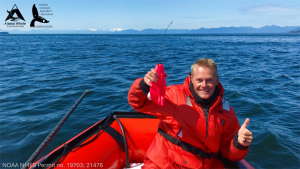Discovering a behavior key to humpback whales' survival and offering a case to include humpbacks among the rare animals that make and wield their own tools is the focus of new research out of the University of Hawaiʻi at Mānoa. Hawaiʻi Institute of Marine Biology researchers have known that humpback whales create "bubble nets" to hunt, but they discovered that they manipulate the bubble net to maximize their food intake in Alaskan feeding grounds.
The research, done in partnership with Alaska Whale Foundation (AWF), was published in Royal Society Open Science.

(Photo credit: MMRP/AWF. Collected under permit)
"Many animals use tools to help them find food, but very few actually create or modify these tools themselves," said Lars Bejder, co-lead author of the study and Marine Mammal Research Program (MMRP) director. "We discovered that solitary humpback whales in southeast Alaska craft complex bubble nets to catch krill, which are tiny shrimp-like creatures. These whales skillfully blow bubbles in patterns that form nets with internal rings, actively controlling details like the number of rings, the size and depth of the net, and the spacing between bubbles. This method lets them capture up to seven times more prey in a single feeding dive without using extra energy."
Success in hunting is key for the whales' survival. Humpback whales' energy budget for the entire year depends on their ability to capture enough food during summer and fall in Alaska. Unraveling the nuances of their carefully honed hunting technique sheds light on how migratory humpback whales consume enough calories to traverse the Pacific Ocean.
Demystifying whale behavior

Marine mammals known as cetaceans include whales, dolphins and porpoises are difficult to study. For this study researchers employed specialty tags and drones to study the whales' movements from above and below the water.
"We deployed non-invasive suction-cup tags on whales and flew drones over solitary bubble-netting humpback whales in Alaska, collecting data on their underwater movements," said William Gough, co-author and MMRP researcher. "The tools have incredible capability, but honing them takes practice. Whales are a difficult group to study, requiring skill and precision to successfully tag and/or drone them."
Improved management to come
Cetaceans throughout the globe face a slough of threats that range from habitat degradation, climate change, fisheries, to chemical and noise pollution. One quarter of the 92 known cetacean species are at risk of extinction, and there is a clear and urgent need to implement effective conservation strategies on their behalf. Understanding this essential behavior makes resource managers better poised to adeptly monitor and conserve the feeding grounds that are critical to their survival.






